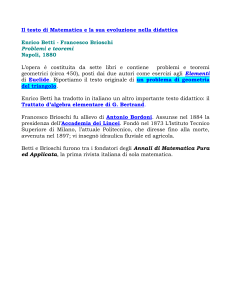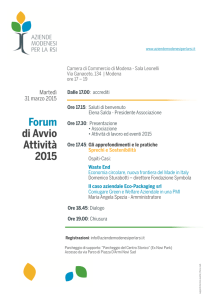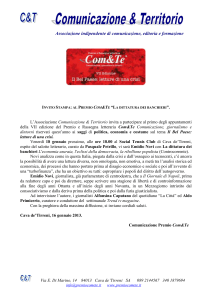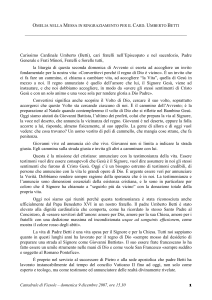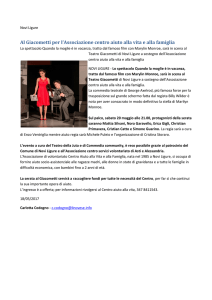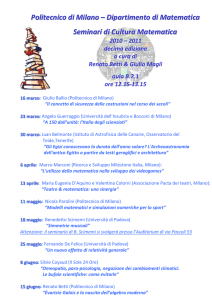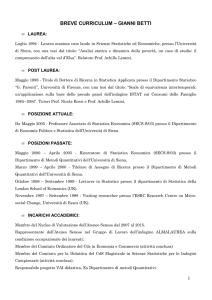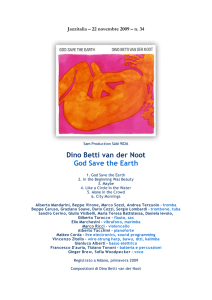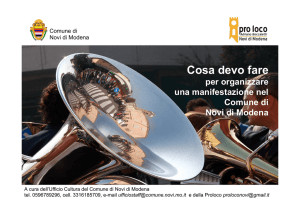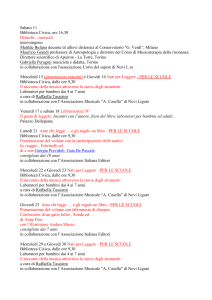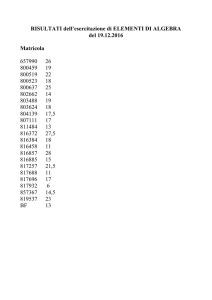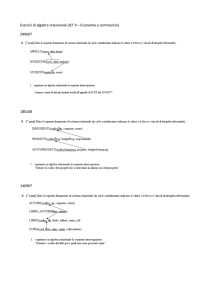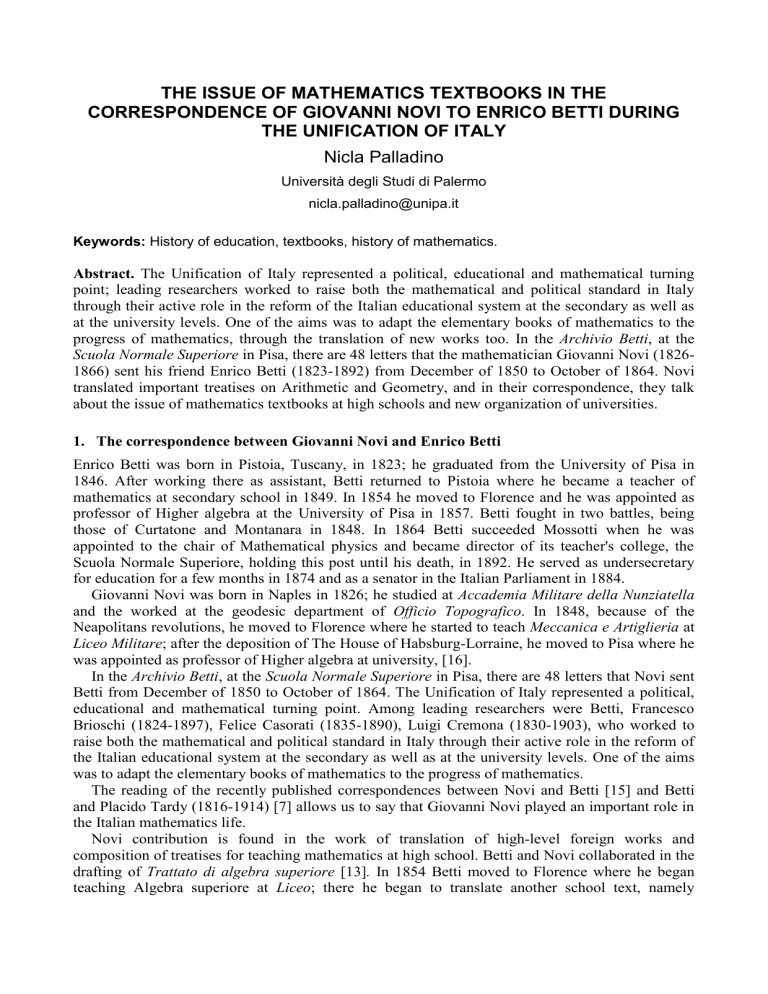
THE ISSUE OF MATHEMATICS TEXTBOOKS IN THE
CORRESPONDENCE OF GIOVANNI NOVI TO ENRICO BETTI DURING
THE UNIFICATION OF ITALY
Nicla Palladino
Università degli Studi di Palermo
[email protected]
Keywords: History of education, textbooks, history of mathematics.
Abstract. The Unification of Italy represented a political, educational and mathematical turning
point; leading researchers worked to raise both the mathematical and political standard in Italy
through their active role in the reform of the Italian educational system at the secondary as well as
at the university levels. One of the aims was to adapt the elementary books of mathematics to the
progress of mathematics, through the translation of new works too. In the Archivio Betti, at the
Scuola Normale Superiore in Pisa, there are 48 letters that the mathematician Giovanni Novi (18261866) sent his friend Enrico Betti (1823-1892) from December of 1850 to October of 1864. Novi
translated important treatises on Arithmetic and Geometry, and in their correspondence, they talk
about the issue of mathematics textbooks at high schools and new organization of universities.
1. The correspondence between Giovanni Novi and Enrico Betti
Enrico Betti was born in Pistoia, Tuscany, in 1823; he graduated from the University of Pisa in
1846. After working there as assistant, Betti returned to Pistoia where he became a teacher of
mathematics at secondary school in 1849. In 1854 he moved to Florence and he was appointed as
professor of Higher algebra at the University of Pisa in 1857. Betti fought in two battles, being
those of Curtatone and Montanara in 1848. In 1864 Betti succeeded Mossotti when he was
appointed to the chair of Mathematical physics and became director of its teacher's college, the
Scuola Normale Superiore, holding this post until his death, in 1892. He served as undersecretary
for education for a few months in 1874 and as a senator in the Italian Parliament in 1884.
Giovanni Novi was born in Naples in 1826; he studied at Accademia Militare della Nunziatella
and the worked at the geodesic department of Officio Topografico. In 1848, because of the
Neapolitans revolutions, he moved to Florence where he started to teach Meccanica e Artiglieria at
Liceo Militare; after the deposition of The House of Habsburg-Lorraine, he moved to Pisa where he
was appointed as professor of Higher algebra at university, [16].
In the Archivio Betti, at the Scuola Normale Superiore in Pisa, there are 48 letters that Novi sent
Betti from December of 1850 to October of 1864. The Unification of Italy represented a political,
educational and mathematical turning point. Among leading researchers were Betti, Francesco
Brioschi (1824-1897), Felice Casorati (1835-1890), Luigi Cremona (1830-1903), who worked to
raise both the mathematical and political standard in Italy through their active role in the reform of
the Italian educational system at the secondary as well as at the university levels. One of the aims
was to adapt the elementary books of mathematics to the progress of mathematics.
The reading of the recently published correspondences between Novi and Betti [15] and Betti
and Placido Tardy (1816-1914) [7] allows us to say that Giovanni Novi played an important role in
the Italian mathematics life.
Novi contribution is found in the work of translation of high-level foreign works and
composition of treatises for teaching mathematics at high school. Betti and Novi collaborated in the
drafting of Trattato di algebra superiore [13]. In 1854 Betti moved to Florence where he began
teaching Algebra superiore at Liceo; there he began to translate another school text, namely
Bertrand's Algebra elementare [4]; in Avvertimento del traduttore, Betti announces his intention to
publish a Corso di Algebra. Betti wrote to Tardy on the 26th February 1858 [7]:
“I am really busy with this course of higher algebra. It is hard and I don't know if I have enought
strenght for this. It is necessary to not be content with these gains of the Science started 30 years
ago and placed side by side; but it is necessary to create one body, well organized in which
everything is in the right place; moreover we need clarity, and rigour and semplicity rathen then
memory. I have organized a quite new plane and I think old and new parts of the Science have the
right conditions to coexist. In the meantime, my lessons at the University are based on this new
Plan. There, I have some smart and passionate students. It is a pleasure for my to go to Genova and
discuss with you about this course. I hope I'll develop it for that moment”.1
Betti’s purpose was actualized by Novi in 1863: he collected Betti’s lessons at lyceum and
university and published Trattato di algebra superiore; in the preface, Novi thanks Betti and
declares the purposes that they wonted to achieve:
“Professor Betti promised this work years ago. [...] But he moved in 1859 to the chair of higher
analysis and this commitment has distracted him from his promise, because of other studies. [...] I
succeeded him on the chair of higher algebra at the University of Pisa and Betti invited me to
perform his promise. He provided his lessons of the years 1858 and 1859, in order to help me in this
aim and he offered advices and assistance with his kindness”.2
Their close friendly relationship is manifest in every letter of the correspondence. Betti wrote to
Tardy from Pisa on the 26th February 1858 [7]:
“I and Brioschi determined that we will meet in Genova, in the Easter holidays, where Genocchi
maybe will be to. We are talking with you about our Giornale; and we are deciding what is
necessary for its best performance. I accepted Brioschi’s call also because I will see You. In the
carnival holisays I was in Florence to to persuade Novi to come with us; but at the moment I can’t
do it”.3
These letters deal with an important decision immediatly after Italian unification: the creation of
a real Italian mathematical journal, able to stand comparison with the most important European
“Io ora sono tutto ed esclusivamente occupato dal Corso di Algebra Superiore. E’ un impresa ardua a cui
non so se basteranno le mie forze. Non bisogna contentarsi di por giù tutti questi nuovi acquisti della Scienza
fatti da 30 anni in quà, uno accanto all’altro; ma bisogna farne un corpo, ben organizzato dove tutto sia al suo
posto; e poi qui più che in una memoria è necessaria chiarezza, e rigore e semplicità. Ho fatto un Piano un
po’ nuovo, e mi pare che su questo vengano bene e naturalmente a disporsi le parti nuove e vecchie della
Scienza. Intanto su questo Piano fo le mie lezioni per l’Università; dove però bisogna che esponga molto di
quello che andrà nel Corso. Ci h qualche giovane capace e che studia con passione. Ho molto piacere di
recarmi a Genova, anche per potere parlare insieme con Te di questo Corso. Speriamo che allora avrò potuto
portarlo molto più avanti”.
2
“Un’opera di tal fatta era stata promessa dal professor Betti, corrono già varii anni [...]. Ma nel 1859 il
professor Betti fu chiamato a dettar lezioni di analisi superiore, ed il nuovo ufficio obbligandolo ad altri
studi, lo distolse di mandare ad effetto il suo primo pensiero [...]. Succeduti noi al professor Betti nella
cattedra di algebra superiore dell’Università di Pisa, fummo dallo stesso esortati ad effettuare la promessa
che le nuove circostanze impedivano a lui di adempire. Per agevolarci questo compito, ingombro di non lievi
difficoltà, egli pose gentilmente a nostra disposizione i manoscritti delle lezioni fatte negli anni 1858 e 59, e
ci offrì i suoi consigli e i suoi aiuti con quella schietta benevolenza che rende sì preziosa la sua amicizia a noi
ed a quanti lo conoscono”.
3
“Abbiamo quasi fissato con Brioschi di trovarsi a Genova nelle vacanze di Pasqua, dove forse verrà anche
Genocchi. Vogliamo parlare un poco anche insieme con Te del nostro Giornale; e stabilire bene tutto ciò che
è necessario per il migliore andamento dello stesso. Io ho accettato l’invito di Brioschi tanto più volentieri,
perché mi darà occasione di stare un poco con Te. Nelle vacanze di Carnevale fui a Firenze, e mi provai a
persuadere il Novi a venire anche Lui; ma per ora non sono riuscito”.
1
journals, founded in the first half of the century, as Journal di Crelle4 or the Annales de
Mathématiques.5 In 1857, Brioschi, with Cremona, Betti and Angelo Genocchi (1817-1889),
decided to carry out a “Project for a new Italian mathematical journal to susbtitute the Annali del
Totolini or create just a continuation”,6 as he wrote in a letter to Genocchi in May 1857 [6]. Novi
himself was invited to Tardy's house during Easter holidays in 1858 for the important meeting
between Brioschi, Tardy, Betti and Genocchi in which they discussed about the Annali di
Matematica pura ed applicata and also to organize the famous trip of Brioschi, Betti and Casorati
around different German and French cities [5], [6].
Some letters between Novi and Betti are dedicated to the reorganization of the mathematical
studies and, as consequence, the engineer carrer. In particular, these themes were examinated in
occasion of the purporse of the Minister Terenzio Mamiani (1799-1885), at the beginning of 1861,
to reorganize the University and adapt the Legge Casati to the new political situation [17]. One of
the aims of the extension of Casati Law of Education was boosting the intellighenzia of the country
through the empowerment of University studies. In 1860 some chair in High Mathematics were
instituted in the main cities of the kingdom, such as the Chair of Higher Geometry delivered to
Cremona at University of Bologna
2. The problem of mathematical books
In 1858 was published the Trattato di Geometria Elementare [12]. In 1860 Cremona wrote an
extensive review on this book: “We have no good elementary books wich are originally Italian ones
and wich correspond to the recent progress of sciences. Perhaps Neapolitans, who were and are
lovers of mathematics; but how can we have some news if that country is more divided from us that
if it was China?”.7 This is held in [8]. The original Amiot’s treatise was Leçons nouvelles de
géométrie élémentaire, [1].
In 1862 Novi wrote Trattato d'aritmetica; prima traduzione italiana con note ed aggiunte di
Giovanni Novi [10], traslated from a work of J. Bertrand [2]. Even by Bertrand [3], Betti had
written Trattato d’algebra elementare, [4] in 1859.
Some great Italian mathematicians, among these Cremona, Betti, Brioschi, had an important role
in the Italian Public Instruction. One of the problems was to give a uniform instruction to citiziens,
updating all elementary and high school books with recent advances of mathematics, using the
translations of new foreign works. The efforts of great mathematicians towards the production of
books didactically effective come from these first attempts, started before Italian Unification..
From 1853, Novi started to dedicate his time to treatises translation, as Novi himself wrote to
Betti on 25th July 1853 [15]:
“I will explain all the reasons I devote all my time to write treatises when I see you or in my next
letter. It must be patient”.8
4
The Journal für die reine und angewandte Mathematik, published by Walter de Gruiter, founded in 1826 in
Berlin by Leopold Crelle (1780-1855), who edited the journal until his death. For this reason it was known as
Giornale di Crelle.
5
Nouvelles annales de mathématique founded in France in 1842 by Olry Terquem (1782-1862) and Camille
Gerono (1799-1892).
6
“Progetto intorno ad un giornale di matematica Italiano da surrogarsi agli Annali del Tortolini, quando non
potesse essere una continuazione di questi”.
7
“Noi non abbiamo buoni libri elementari che siano originali italiani e giungano al livello de’ progressi
odierni della scienza. Forse ne hanno i Napoletani che furono sempre e sono egregi cultori delle
matematiche; ma come può aversi certa notizia se quel paese è più diviso da noi che se fosse la China?”.
8
“Quando ci vedremo, o se tarderai quando ti scriverò nuovamente, ti dirò le ragioni per le quali debbo
dimenticare ogni cosa per varii mesi e mettermi a scrivere trattati, la fatica più esimia di questo mondo. Ci
vuol pazienza”.
This is one of the scientific initiatives carried out by Italian scientists after the known “Decennio
di preparazione”. The aim of these works is expressed in the preface of Trattato di Geometria
elementare di A. Amiot [12]:
“All works with the aim to initiate young people into science have to include all theorical basis,
considered fundamental. This is the reason why it is necessary change elementary books following
new treatises”.9
It was important the attention that Luigi Cremona dedicated to the question; in his text
“Considerazioni”, Cremona praised the personal work of Novi, who enhanced the original work
written in 1850 by Amiot Leçons nouvelles de géométrie élémentaire; Creomona also agreed with
the initiative of the publisher to update the book with all the last progress of Mathematics; he wrote:
“Only people who read them can express the merit of these publications. It has been chosen the
best works among the most recent and enriched ones by precious notes. So thanks to the work of
those men mentioned before, we have the best works on arithmetic, algebra and geometry. We hope
this is only the beginning”.10
Cremona ended the “Considerazioni” inviting all to turn the attention to Novi's notes “Designed
for the development of recent theories”11 and to “Short notes, written by the translator, with the aim
to indicate the new consequences of the theory expressed by the author, or simply demostrations, or
general way to considerer some themes”.12
In 1863 Novi wrote the Trattato di algebra superiore – Parte Prima, Analisi Algebrica; in
preface, he wrote:
“We diveded the work in three parts. In the first we explain the theory of the series, of infinitive
products and continued fractions; in the second part, based on the rational algebric fractions, there
are the theory of determiners, of symmetrical functions, of the elimination and the most important
and modern of the linear transformation for homogeneous functions; in the third part, we expose the
irrational algebric functions and the results of some modern scientists, as Betti, Hermite,
Knonecker, Weierstrass, ecc. about the algebric resolution of the equation.
Now, we only publish the fist part, named Analisi algebrica, following the example of other
scientists”.13
In Trattato di Algebra Superiore’s index, these arguments are written: Nozioni sulla teoria delle
combinazioni, Numeri complessi, Limiti e continuità delle funzioni, Serie, Convergenza delle serie,
Serie doppie, Serie potenziale, Serie esponenziale e logaritmica, Serie circolari ed iperboliche,
“Le opere destinate ad iniziare i giovani nello studio di una scienza, debbono contenere le basi teoriche che
per la loro generalità e fecondità vogliono esser considerate come fondamentali. E ciò rende ragione perché
di tratto in tratto sia necessario mutare i libri elementari”.
10
“Il merito di queste interessanti publicazioni non può essere ritratto in brevi parole, né può appieno sentirsi
se non da chi le abbia avute in mano, e con diligenza studiate. Non solo sono state scelte le migliori opere
originali fra le recentissime, ma anche furono arricchite ed ampliate con preziose note ed aggiunte, che ne
accrescono singolarmente il pregio. Così, per le utili fatiche de'chiari uomini nominati, noi possediamo
attualmente ottimi trattati d'aritmetica, d' algebra, di trigonometria e di geometria. Facciamo voti che sì
eccellenti principj siano seguiti da cose maggiori”.
11
“Destinate quasi esclusivamente allo sviluppo delle teorie recenti soltanto abbozzate nel testo”.
12
“brevi note, poste dal traduttore, allo scopo di indicare nuove conseguenze de' teoremi esposti dall' autore,
o più semplici dimostrazioni, o maniere più generali di considerare certi argomenti”.
13
“Abbiamo divisa l’opera in tre parti. Nella prima si espone quanto si riferisce alla teoria delle serie, dei
prodotti infiniti e delle frazioni continue; nella seconda, che volge intorno alle frazioni algebriche razionali,
si troveranno le teorie dei determinanti, delle funzioni simmetriche, dell’eliminazione e quella
importantissima e tutta moderna delle trasformazioni lineari per le funzioni omogenee; nella terza finalmente
si tratta delle funzioni algebriche irrazionali, e vengono dichiarati i risultati a cui sono giunti alcuni geometri
moderni, quali Betti, Hermite, Kronecker, Weierstrass ec., circa alla risoluzione algebrica dell’equazioni.
Oggi pubblichiamo la sola prima parte, che distinguiamo col nome di analisi algebrica, per seguire
l’esempio di altri geometri”.
9
Ulteriori ricerche sulle serie, Prodotti infiniti, Facoltà analitiche, Frazioni continue, Riduzione
delle frazioni continue in serie e in prodotti infiniti e viceversa.
Novi discussed about his treatise with Angelo Genocchi, as it is possible to observe reading the
only letter left that Novi sent to Genocchi from Pisa the 28th of December 1863 [16].
In 1857, Novi published Elementi d'aritmetica [11] and in the "Avvertenza" declaired that they
were only the preliminaries of Trattato d'aritmetica di Giuseppe Bertrand; prima traduzione
italiana con note ed aggiunte di Giovanni Novi, traslated from Traité d'arithmétique in 1849.
Elementi d'aritmetica is constituited of 150 pages on: addizione e sottrazione, moltiplicazione,
divisione, divisori di numeri - numeri primi, frazioni, numeri decimali, numeri complessi, rapporti e
proporzioni, regole del tre, problemi, sistema metrico.
3. Conclusions
Italian scholars paid modest attention to Giovanni Novi, in the field of research concerning
mathematicians during the period of Italian Unification. The reading of the recently published
correspondences allows us to say that Giovanni Novi played an important role in the Italian
mathematics life. He was in close friendship with Betti, Tardy and in close touch with Giuseppe
Battaglini (1826-1894), Barnaba Tortolini (1808-1874), Genocchi, Francesco De Sanctis (18171883), Ottaviano Fabrizio Mossotti (1791-1863), Eugenio Beltrami (1836-1900), Cremona,
Bernhard Riemann.14 Novi contribution is found in the work of translation of high-level foreign
works and composition of treatises for teaching mathematics at high school. His productions
includes: Elementi d'aritmetica; the translation Memoria sopra le trasformazioni generali di date
funzioni. Estratto di un opuscolo del sig. O. Schlömilch, Sul moto dei proietti nell'anima delle
bocche da fuoco, the translation Elogio di Carlo Gustavo Jacob Jacobi letto nell’Accademia delle
Scienze di Berlino il 1° di luglio 1852 da Lejeune Dirichlet, the review Lezioni di Meccanica
razionale di O. F. Mossotti, La Statica dei sistemi di forma invariabile di F. Brioschi, Milano 1859,
Elementi di Meccanica razionale di D. Chelini delle Scuole Pie published in Annali di Scienze
matematiche e fisiche15; Riduzione in serie delle facoltà analitiche and Sugl’invarianti e i covarianti
delle forme binarie published in 1864 in “Giornale di Matematiche”16 by Battaglini; the
unpublished Lezioni di Artiglieria.
Novi translations of Amiot and Bertrans treatises were republished, as the chart shows:
1858. Trattato di Geometria elementare di A.
Amiot, prima traduzione italiana con note ed
1856. Trattato d'aritmetica di Giuseppe
aggiunte di Giovanni Novi, Professore di Bertrand; prima traduzione italiana con note ed
Meccanica nel R. Liceo militare di Firenze, con aggiunte di Giovanni Novi. Firenze, Le Monnier.
un atlante di 59 tavole. Firenze, Le Monnier.
1881. Trattato di geometria elementare di A.
1862. Trattato d'aritmetica di Giuseppe
Amiot; prima traduzione italiana con note ed Bertrand; prima traduzione italiana con note e
aggiunte di Giovanni Novi. Firenze, successori aggiunte di Giovanni Novi. Firenze, Le Monnier.
14
Bernhard Riemann (1826-1866); from October 1863 to July 1865, he moved to Pisa because of health
problems.
15
The Annali, edited by Tortolini and published in Rome from 1850 to 1865, were known as “Annali di
Tortolini”, but their full name was “Annali di Scienze matematiche e fisiche”. From 1865, Enrico Betti,
Francesco Brioschi and Angelo Genocchi started to collaborate with Tortolini and the journal name became
“Annali di matematica pura e applicata”. In 1865 all publications stopped and started again in Milan from
July 1867 directed by Francesco Brioschi and Luigi Cremona.
16
In 1863, Giuseppe Battaglini founded the “Giornale di matematica ad uso degli studenti delle Università
italiane” with Vincenzo Janni (1819-1891) and Nicola Trudi (1811-1884). From 1866 to 1893, Battaglini
edited the journal and for this reason it was generally knonw as “Giornale di Battaglini”.
Le Monnier.
1899. Trattato di geometria elementare di A.
1886 Trattato d'aritmetica di Giuseppe
Amiot; prima traduzione italiana, con note ed Bertrand; prima traduzione italiana con note ed
aggiunte di Giovanni Novi. Firenze, Successori aggiunte di Giovanni Novi. Firenze, F. Le
Le Monnier.
Monnier.
1894. Trattato d'aritmetica di Giuseppe
Bertrand; traduzione italiana con note ed
aggiunte di Giovanni Novi. Nuova edizione con
modificazioni ed aggiunte per cura di Antonio
Socci. Firenze, Successori Le Monnier.
1920. Trattato d'aritmetica di Giuseppe
Bertrand; traduzione italiana con note ed
aggiunte di Giovanni Novi. Nuova edizione con
modificazioni ed aggiunte per cura del dott.
Antonio Socci. Firenze, Le Monnier.
One direct result of these early works, begun following the Unification of Italy, was the
involvement of the great mathematicians in the writing of works that were educationally effective
and closer to the scientific results that were just being achieved at the time.
REFERENCES
[1] Amiot A., Leçons nouvelles de géométrie élémentaire, Parigi, Dezobry et E. Magdeleine libraireséditeurs, 1850.
[2] Bertrand J., Traité d'arithmétique, Paris, Hachette, 1849.
[3] Bertrand J., Traité élémentaire d’algèbre, Paris, Hachette, 1850.
[4] Betti E., Trattato di algebra elementare. Prima traduzione italiana con note ed aggiunte di Enrico Betti,
Firenze, Le Monnier, 1856.
[5] Bottazzini U., Va’ pensiero. Immagini della Matematica nell’Italia dell’Ottocento, Bologna, Il Mulino,
1994.
[6] Carbone L., Mercurio A.M., Palladino F., Palladino N., La corrispondenza epistolare Brioschi-Genocchi, pp. 273274.
[7] Cerroni C., Martini L., Il carteggio Betty-Tardy (1850-1891), Milano, Mimesis, 2010.
[8] Cremona L., Considerazioni di storia della geometria, in occasione di un libro di geometria elementare
pubblicato recentemente a Firenze, Il Politecnico, vol. IX, Milano, Editori del Politecnico, 1860, pp. 286322.
[9] Lessico Universale Italiano, Istituto della Enciclopedia Italiana fondata da Giovanni Treccani, Roma, Arti
grafiche Marchesi per i tipi dell’Istituto Poligrafico e Zecca dello Stato, www.treccani.it.
[10]
Novi G., Trattato d'aritmetica. Prima traduzione italiana con note ed aggiunte di Giovanni Novi,
Firenze, Le Monnier, 1856.
[11]
Novi G., Elementi d’aritmetica, Firenze, Le Monnier, 1859.
[12]
Novi G., Trattato di Geometria elementare di A. Amiot, prima traduzione italiana con note ed
aggiunte di Giovanni Novi, Firenze, Felice Le Monnier, 1858.
[13]
Novi G., Trattato di Algebra superiore, Parte I. Analisi algebrica, Firenze, Le Monnier, 1863.
[14]
Palladino F., Mercurio A.M., Palladino N., Per la costruzione dell’Unità d’Italia. Le corrispondenze
epistolari Brioschi - Cremona e Betti - Genocchi, Firenze, Olschki, 2009.
[15]
Palladino N., Mercurio A.M., La corrispondenza Giovanni Novi - Enrico Betti, Rendiconto
dell’Accademia delle Scienze Fisiche e Matematiche di Napoli, 2011.
[16]
N. Palladino, Giovanni Novi (1826-1866). La corrispondenza con Enrico Betti ed il suo contributo
matematico, in “Europa Matematica e Risorgimento Italiano”, BOLOGNA, Clueb, 2012.
[17]
Polenghi S., La politica universitaria italiana nell’età della Destra storica, Brescia, Editrice La
Scuola, 1993.

